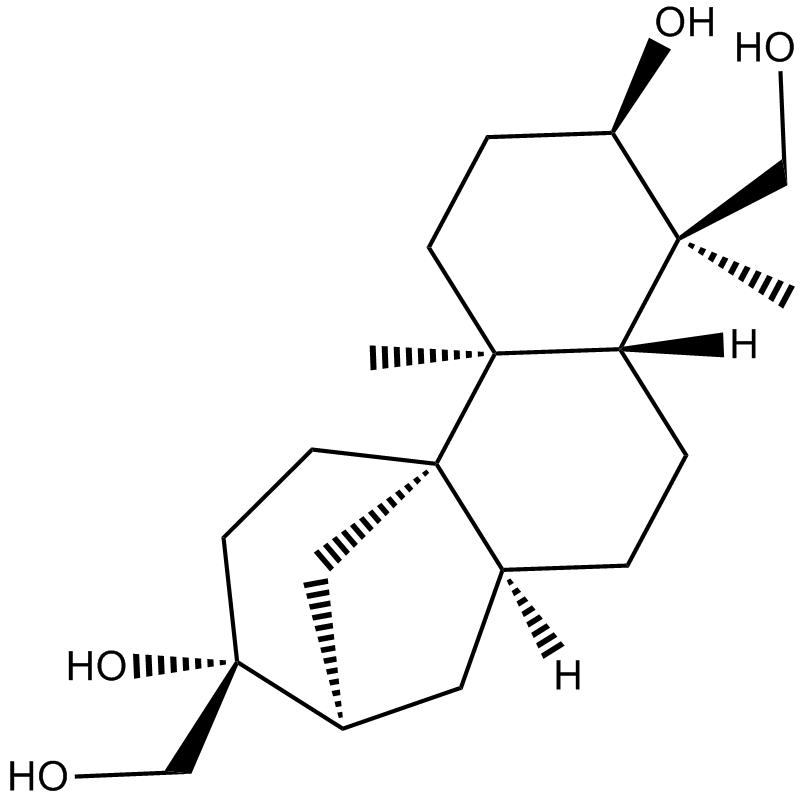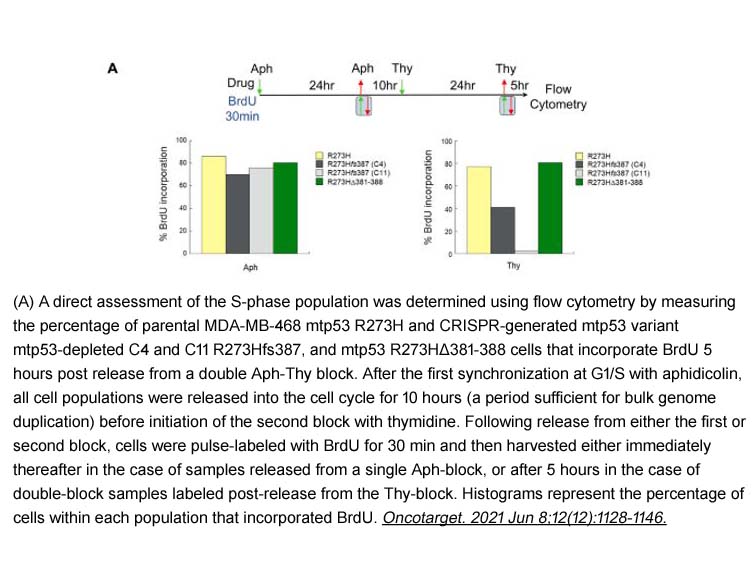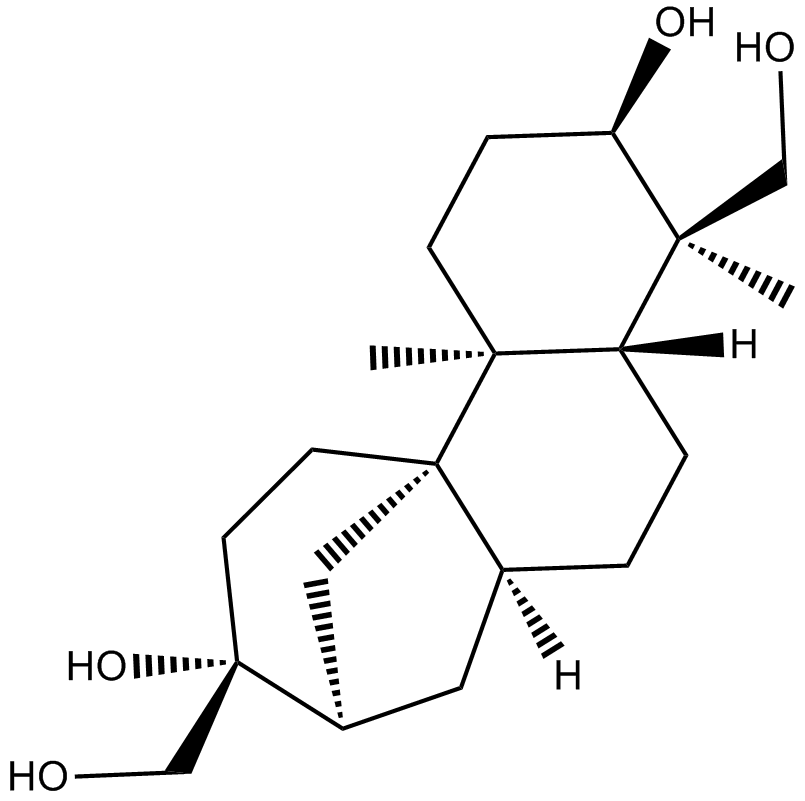(+)-Aphidicolin
Aphidicolin, a tetracyclic diterpenoid, is an antibiotic with novel structure produced by the mold Cephalosporium aphidicola. Aphidicolin is an inhibitor of DNA polymerase-α [1].
DNA polymerase-α is an enzyme complex involved in initiation of DNA replication and during synthesis of Okazaki fragments on the lagging strand. The DNA polymerase-α complex consists of 4 subunits: POLA1, POLA2, PRIM1, and PRIM2. POLA1 is the catalytic subunit. POLA2 is the regulatory subunit. PRIM1 and PRIM2 are the small and the large primase subunits [2].
Aphidicolin selectively inhibited the activity of DNA polymerase-α without activity for DNA polymerase-β and mitochondrial DNA polymerase. Aphidicolin prevented cell division in sea urchin embryos [1]. Aphidicolin was a potent inhibitor of cellular deoxyribonucleic acid synthesis. Aphidicolin strongly inhibited the growth of herpes simplex virus both in tissue culture and in the rabbit eye. Aphidicolin was active against iododeoxyuridine-resistant herpes virus [3]. Aphidicolin showed antiviral activity and inhibited the incorporation of thymidine into DNA of cultured human embryonic lung cells. Aphidicolin (15 μg/ml) reduced the activity of crude and partially purified DNA polymerases from the cytosol [4].
References:
[1] Ikegami S, TAGUCHI T, OHASHI M, et al. Aphidicolin prevents mitotic cell division by interfering with the activity of DNA polymerase-α[J]. Nature, 1978, 275(5679): 458-460.
[2] Lehman I R, Kaguni L S, Krause K H, et al. DNA polymerase alpha[J]. J. Biol. Chem, 1989, 264.
[3] Bucknall R A, Moores H, Simms R, et al. Antiviral effects of aphidicolin, a new antibiotic produced by Cephalosporium aphidicola[J]. Antimicrobial agents and chemotherapy, 1973, 4(3): 294-298.
[4] Ohashi M, Taguchi T, Ikegami S. Aphidicolin: a specific inhibitor of DNA polymerases in the cytosol of rat liver[J]. Biochemical and biophysical research communications, 1978, 82(4): 1084-1090.
- 1. Viola Ellison, Alla Polotskaia, et al. "A cancer persistent DNA repair circuit driven by MDM2, MDM4 (MDMX), and mutant p53 for recruitment of MDC1 and 53BP1 on chromatin." Nucleic Acids Res. 2025 Jul 8;53(13):gkaf627 PMID: 40626562
- 2. Viola Ellison, George K. Annor, et al. "Frame-shift mediated reduction of gain-of-function p53 R273H and deletion of the R273H C-terminus in breast cancer cells result in replication-stress sensitivity." Oncotarget. 2021 Jun 8;12(12):1128-1146. PMID:34136083
| Physical Appearance | A white to off- |
| Storage | Store at -20°C |
| M.Wt | 338.48 |
| Cas No. | 38966-21-1 |
| Formula | C20H34O4 |
| Solubility | ≥33.33 mg/mL in DMSO; insoluble in EtOH; insoluble in H2O |
| Chemical Name | (3R,4R,4aR,6aS,8R,9R,11aS,11bS)-4,9-bis(hydroxymethyl)-4,11b-dimethyltetradecahydro-8,11a-methanocyclohepta[a]naphthalene-3,9-diol |
| SDF | Download SDF |
| Canonical SMILES | C[C@](CO)([C@H]1[C@](C)(CC2)[C@](C[C@H]3C4)(CC[C@@]3(CO)O)[C@H]4CC1)[C@@H]2O |
| Shipping Condition | Small Molecules with Blue Ice, Modified Nucleotides with Dry Ice. |
| General tips | We do not recommend long-term storage for the solution, please use it up soon. |
| Cell experiment:[1] | |
|
Cell lines |
HeLa cells |
|
Reaction Conditions |
0.03 ~ 30 μM aphidicolin for 12 h incubation |
|
Applications |
Treatment with low aphidicolin concentrations (0.03 and 0.3 μM) resulted in increasing normalized integrated nuclear intensity (NINI) values which corresponded to a block in G2/M phase, while high aphidicolin concentrations (3 and 30 μM) led to NINI values that corresponded to G1 phase. In addition, in HeLa cells pretreated with aphidicolin (0.01 ~ 10 μM), a dose-dependent decrease in percentage of Ebola virus (EBOV) infected cells was observed. Thus, aphidicolin was able to arrest cells in the G1/S boundary and restrict EBOV infection. |
|
Note |
The technical data provided above is for reference only. |
|
References: 1. Kota KP, Benko JG, Mudhasani R, et al. High content image based analysis identifies cell cycle inhibitors as regulators of Ebola virus infection. Viruses, 2012, 4(10): 1865-1877. |
|
Quality Control & MSDS
- View current batch:
-
Purity = 98.00%
- COA (Certificate Of Analysis)
- MSDS (Material Safety Data Sheet)
Chemical structure

Related Biological Data









